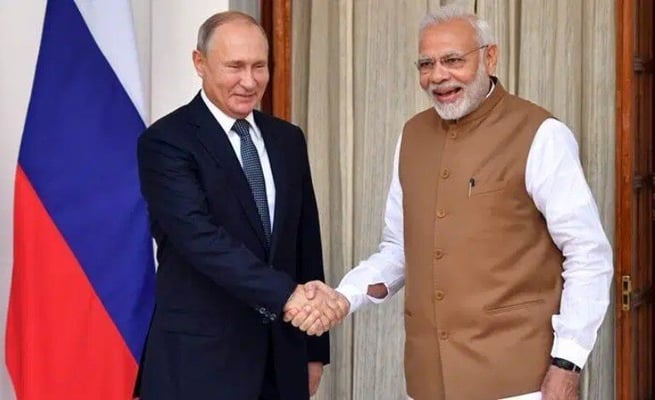Eyes firmly on Indo-Pacific, India quietly launch ‘Act Far East Policy’

India's Prime Minister Narendra Modi on Wednesday, September 5, had quietly announced another 'move-up' of its Look East Policy, by unveiling "Act Far-East Policy," in Russia's Far East region.
Mr Modi was in Russia's Far East region, addressing the plenary session of the 5th Eastern Economic Forum in Vladivostok, when he unveiled the "Act Far East" policy, in the presence of Russian President Vladimir Putin, to boost India's engagement with Russia's Far East region.
Mr Modi also announced a $1 billion line of credit for the development of the resource-rich region.
Indeed, this was another 'move-up' to India's Look East Policy, and by far the most ambitious, bold, and imaginative that the country has seen in the last two decades, as it makes explicitly clear that the primary goal of the country's current strategic thinking is to shore-up the concept of Indo-Pacific.
The announcement, though appearing benign at the moment, has the potential of becoming a historic and defining moment, in India's path of attaining full strategic maturity, as it moves steadily towards finding its natural place in the Indo-Pacific as a key strategic player.
It finally brings together the two most important underlying themes of India's strategic thinking – the Look East policy and the Indo-Pacific – with the former abetting the later, as the desired end goal.
Russia's Far East is a resource-rich and sparsely-populated region in the easternmost territory of Russia, between Lake Baikal in Eastern Siberia and the Pacific Ocean.
India's active and benign presence in this far-off region, right at the mouth of the Pacific Ocean as a part of its newly announced "Act Far East Policy" will further accentuate and legitimise India's rightful claim of being a key player within the fast-emerging Indo-Pacific region.
It is important to note that Indo-Pacific looms large in the current Indian strategic thinking, with the primary goal of shoring-up India's material capabilities, influence and partnership with like-minded players in the region.
The concept of the Indo-Pacific is based on the premise that the Indian and the Pacific Oceans form a single strategic space and underscores the growing importance of India as a strategic player in Asia's regional security architecture.
International commentators began using "Indo-Pacific" in a strategic sense from about 2005, but the term started getting traction in Indian, Australian, and US official documents and speeches by 2010-2014.
New Zealand, in the South Pacific region, a country with a large thriving Indian diaspora, has come to the party as late as 2019 in officially shedding its long-held reticence, if not ambivalence, toward acknowledging the 'Indo-Pacific' as the alternative geopolitical label to the old 'Asia Pacific'.
The fact that Prime Minister Modi has ‘moved-up’ the longstanding Look East Policy in a manner that it further shores-up Indo-Pacific is indeed a masterstroke.
The Look East Policy has been India's longstanding, and probably, the most successful foreign-economic-strategic policy that has been regularly 'moved-up' by successive governments in New Delhi to enhance the scope, the focus, geographic reach and the ambitions.
The policy was initially launched by former Prime Minister Narsimha Rao in 1992, immediately after the end of the cold war, and sought looking towards the countries, and regional and global players of the east, as the source of inspiration and partnership in India's own growth trajectory.
Since then the policy had been regularly 'moved-up' to enhance the scope, the focus, geographic reach and the ambitions, of what it initially sought to achieve for India's overall interests.
The policy was cultivated and developed as Look East Policy (phase II) under the Prime Minister Atal Behari Vajpayee (1998-2004), subsequently pursued rigorously under Prime Minister Manmohan Singh (2004–2014), and then most famously moved-up as "Act East Policy" in Prime Minister Modi's first tenure (2014-2019).
Every 'move-up' of this policy, was a natural, linear, uni-dimensional boost, demonstrating India's incremental progress in developing its own material capabilities, and in slowly enmeshing with the region. There was also an unmistakable push towards reaching for the Pacific Ocean, as a key strategic player of the region with the primary goal of safeguarding its national interests, more than anything else.
However, the recent move-up announced by Prime Minister Modi in Russia's Far East, is the most audacious, imaginative and multidimensional, as it takes India right at the mouth of the Pacific Ocean, thus further accentuating the fact that India and the Pacific are one conjoined strategic theatre.
This latest "Act Far East Policy" announcement makes explicitly clear that the primary goal of India's current strategic thinking is to shore-up the concept of Indo-Pacific.
Indeed, the international community will also have lesser and lesser reservations now in being reluctant towards the Indo-Pacific, as India successfully enmeshes with the Pacific region, based on its tangible national interests.
India's Prime Minister Narendra Modi on Wednesday, September 5, had quietly announced another 'move-up' of its Look East Policy, by unveiling "Act Far-East Policy," in Russia's Far East region.
Mr Modi was in Russia's Far East region, addressing the plenary session of the 5th Eastern Economic Forum...
India's Prime Minister Narendra Modi on Wednesday, September 5, had quietly announced another 'move-up' of its Look East Policy, by unveiling "Act Far-East Policy," in Russia's Far East region.
Mr Modi was in Russia's Far East region, addressing the plenary session of the 5th Eastern Economic Forum in Vladivostok, when he unveiled the "Act Far East" policy, in the presence of Russian President Vladimir Putin, to boost India's engagement with Russia's Far East region.
Mr Modi also announced a $1 billion line of credit for the development of the resource-rich region.
Indeed, this was another 'move-up' to India's Look East Policy, and by far the most ambitious, bold, and imaginative that the country has seen in the last two decades, as it makes explicitly clear that the primary goal of the country's current strategic thinking is to shore-up the concept of Indo-Pacific.
The announcement, though appearing benign at the moment, has the potential of becoming a historic and defining moment, in India's path of attaining full strategic maturity, as it moves steadily towards finding its natural place in the Indo-Pacific as a key strategic player.
It finally brings together the two most important underlying themes of India's strategic thinking – the Look East policy and the Indo-Pacific – with the former abetting the later, as the desired end goal.
Russia's Far East is a resource-rich and sparsely-populated region in the easternmost territory of Russia, between Lake Baikal in Eastern Siberia and the Pacific Ocean.
India's active and benign presence in this far-off region, right at the mouth of the Pacific Ocean as a part of its newly announced "Act Far East Policy" will further accentuate and legitimise India's rightful claim of being a key player within the fast-emerging Indo-Pacific region.
It is important to note that Indo-Pacific looms large in the current Indian strategic thinking, with the primary goal of shoring-up India's material capabilities, influence and partnership with like-minded players in the region.
The concept of the Indo-Pacific is based on the premise that the Indian and the Pacific Oceans form a single strategic space and underscores the growing importance of India as a strategic player in Asia's regional security architecture.
International commentators began using "Indo-Pacific" in a strategic sense from about 2005, but the term started getting traction in Indian, Australian, and US official documents and speeches by 2010-2014.
New Zealand, in the South Pacific region, a country with a large thriving Indian diaspora, has come to the party as late as 2019 in officially shedding its long-held reticence, if not ambivalence, toward acknowledging the 'Indo-Pacific' as the alternative geopolitical label to the old 'Asia Pacific'.
The fact that Prime Minister Modi has ‘moved-up’ the longstanding Look East Policy in a manner that it further shores-up Indo-Pacific is indeed a masterstroke.
The Look East Policy has been India's longstanding, and probably, the most successful foreign-economic-strategic policy that has been regularly 'moved-up' by successive governments in New Delhi to enhance the scope, the focus, geographic reach and the ambitions.
The policy was initially launched by former Prime Minister Narsimha Rao in 1992, immediately after the end of the cold war, and sought looking towards the countries, and regional and global players of the east, as the source of inspiration and partnership in India's own growth trajectory.
Since then the policy had been regularly 'moved-up' to enhance the scope, the focus, geographic reach and the ambitions, of what it initially sought to achieve for India's overall interests.
The policy was cultivated and developed as Look East Policy (phase II) under the Prime Minister Atal Behari Vajpayee (1998-2004), subsequently pursued rigorously under Prime Minister Manmohan Singh (2004–2014), and then most famously moved-up as "Act East Policy" in Prime Minister Modi's first tenure (2014-2019).
Every 'move-up' of this policy, was a natural, linear, uni-dimensional boost, demonstrating India's incremental progress in developing its own material capabilities, and in slowly enmeshing with the region. There was also an unmistakable push towards reaching for the Pacific Ocean, as a key strategic player of the region with the primary goal of safeguarding its national interests, more than anything else.
However, the recent move-up announced by Prime Minister Modi in Russia's Far East, is the most audacious, imaginative and multidimensional, as it takes India right at the mouth of the Pacific Ocean, thus further accentuating the fact that India and the Pacific are one conjoined strategic theatre.
This latest "Act Far East Policy" announcement makes explicitly clear that the primary goal of India's current strategic thinking is to shore-up the concept of Indo-Pacific.
Indeed, the international community will also have lesser and lesser reservations now in being reluctant towards the Indo-Pacific, as India successfully enmeshes with the Pacific region, based on its tangible national interests.









Leave a Comment